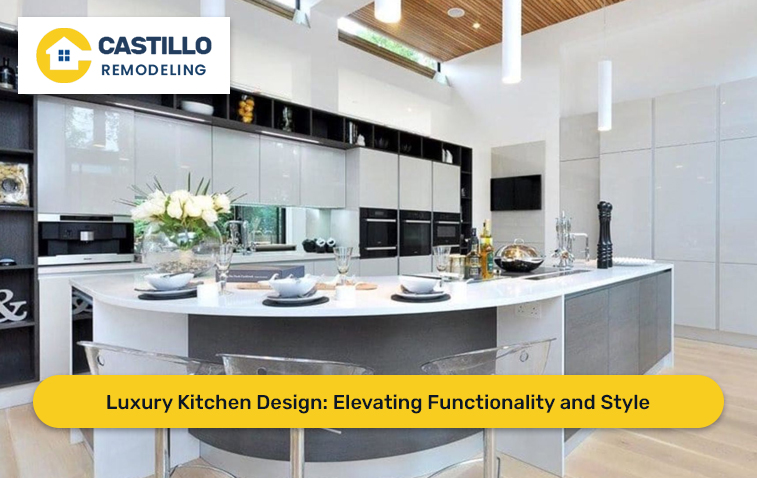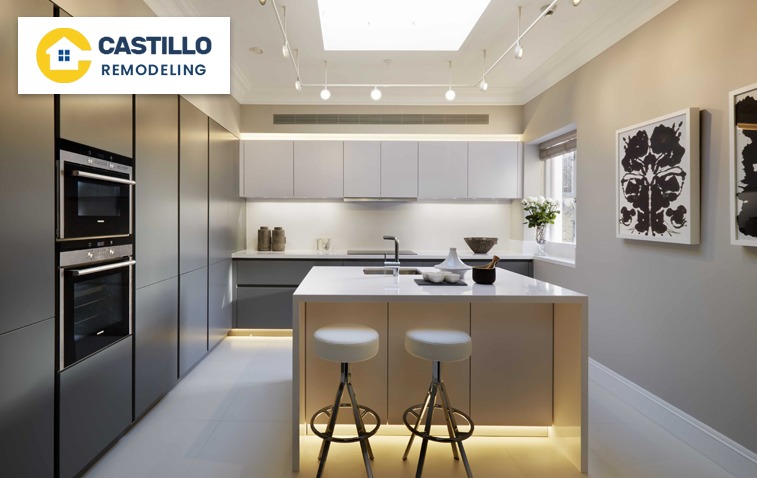In today’s dynamic home environments, luxury kitchen design seamlessly blends style with practicality. Modern kitchen designs focus on transforming ordinary spaces into extraordinary ones, combining high-quality materials, innovative technology, and thoughtful design. This approach creates kitchens that are not only visually stunning but also highly functional. Explore how luxury kitchen design redefines the kitchen experience, merging elegance with everyday convenience for an exceptional home environment.

A luxury kitchen is not just a place to prepare meals; it’s a central gathering space where culinary creativity thrives, families connect, and lasting memories are made. To infuse your kitchen remodel with high-end design elements:
The work triangle theory suggests arranging the three primary kitchen components—the sink, stove, and refrigerator—in a triangular layout. This design approach enhances efficiency by minimizing unnecessary steps and streamlining the cooking process. Implementing the work triangle concept is essential for achieving a well-organized and functional kitchen. Picture preparing meals and hosting gatherings with ease, without the hassle of navigating a cluttered or inefficient space.
Keeping your kitchen organized and clutter-free makes cooking and entertaining an enjoyable space. Evaluating your current storage situation and identifying any spaces that could benefit from additional storage solutions.
Utilizing vertical space with shelves and cabinets and investing in storage accessories like drawer dividers and pull-out organizers can make a big difference in creating an efficient and functional kitchen.
Your chosen appliances should fit your style and serve their intended purpose efficiently, allowing you to cook and prepare meals quickly. When selecting appliances, it is essential to consider factors such as size, capacity, and energy efficiency.
Additionally, think about your cooking habits and needs. If you love to bake, a quality oven is a must; if you have a large family, a spacious refrigerator is necessary.
Incorporating a kitchen island or peninsula is a smart move when it comes to creating the perfect kitchen – not only does it offer additional counter space, but it can also provide extra storage and seating. A well-designed island or peninsula can also be a hub for prep work, cooking, and socializing with guests and family. Opt for materials and finishes that complement your existing cabinetry and flooring, and make sure to include ample storage solutions and functional accessories, such as built-in appliances or a sink.
Adequate lighting helps create a safer and more functional space while also boosting the overall aesthetic. Installing LED light fixtures, under cabinet lighting, and dimmer switches are all cost-effective options when considering the best way to utilize efficient lighting in your kitchen. These solutions will provide enough light for cooking, serving, and cleaning, reduce energy usage, and save money on electricity bills.
Kitchen surfaces are constantly exposed to heat, moisture, and spills, so choosing materials that can withstand daily wear and tear is essential. Quartz countertops, porcelain floor tiles, and stainless steel appliances are sturdy and resistant to scratches, stains, and water damage. Additionally, opting for materials that are easy to clean, such as subway tile, avoids the buildup of grime and grease, which not only helps the kitchen look great but also prevents bacteria from accumulating.
A perfectly functional kitchen allows for easy movement around the space, regardless of how many people are in it. The ideal layout should allow for effortless navigation between the cooking, cleaning, and eating areas. To avoid traffic congestion, doors, and appliances should open in a direction that doesn’t interrupt the flow of the kitchen.
It all starts with customizing the space to fit your needs. One effective way to do this is to create designated zones for specific activities, such as food prep, cooking, and cleanup. Including a multi-functional island can also enhance the functionality of your kitchen space.
Incorporating features like adjustable shelving, rollout trays, and pullout cabinets, you can maximize your storage space and make accessing all your cooking essentials easier.
A cluttered and dirty kitchen not only affects the efficiency of your cooking but it can also be a safety hazard. Keeping the countertops clear and the floor free of spills and debris should be a daily practice.
Investing in organizational tools such as shelving, drawer dividers, and labeled containers can help you keep track of your kitchen supplies and reduce clutter. Make sure to regularly clean and sanitize surfaces, appliances, and utensils to prevent the spread of harmful bacteria.
Inadequate ventilation in kitchens can result in unpleasant odors, smoke accumulation, and potentially hazardous levels of carbon monoxide. To maintain good air quality, it’s important to choose a ventilation system that is appropriately sized and well-placed. Whether you select a traditional range hood or a modern downdraft system, make sure to evaluate your kitchen’s layout and size to achieve optimal ventilation.
Modern kitchens are designed for both style and functionality. Key trends include:
Layered Lighting:
Energy-Efficient Lighting:
Accent Lighting:
Voice-Activated Controls:
Built-In Charging Stations:
Smart Faucets:
Technology Integration:

A kitchen remodel is an opportunity to create a space that combines luxury, functionality, and modern design. Focus on efficiency, high-quality materials, bold finishes, layered lighting, and integrated technology to craft a kitchen that enhances your home and lifestyle. For expert guidance on your remodel, consult with a professional remodeler to ensure a smooth and successful transformation.